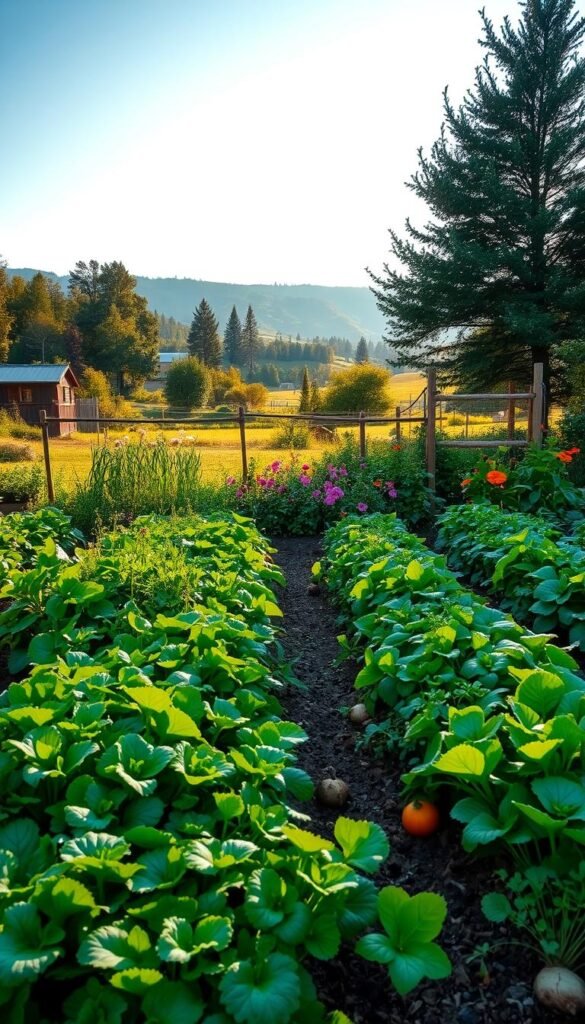Growing vegetables becomes more rewarding when you let nature do the heavy lifting. Strategic plant pairings create a self-sustaining ecosystem where crops protect each other from pests, share nutrients, and boost growth. This method reduces reliance on chemicals while helping your greens thrive.
Research shows certain combinations deliver real results. Basil repels aphids near tomatoes, while marigolds shield roots from harmful nematodes. Legumes like beans add nitrogen to soil – studies prove they can enrich earth with 200 pounds of nitrogen per acre annually. Even simple choices matter: clover as ground cover increases soil fertility by 30%.
You’ll discover how to design plant communities for stronger, healthier through every season. These partnerships cut weed growth by 60% and attract 58% more pollinators compared to single-crop beds. The best part? You’re working with nature instead of against it.
Smart spacing lets you grow more in less area while keeping plants vigorous. We’ll share science-backed pairings that increase yields by 25% over three years – no guesswork required. Get ready to cultivate a resilient, productive space where every plant plays a vital role.
Understanding the Basics of Companion Planting
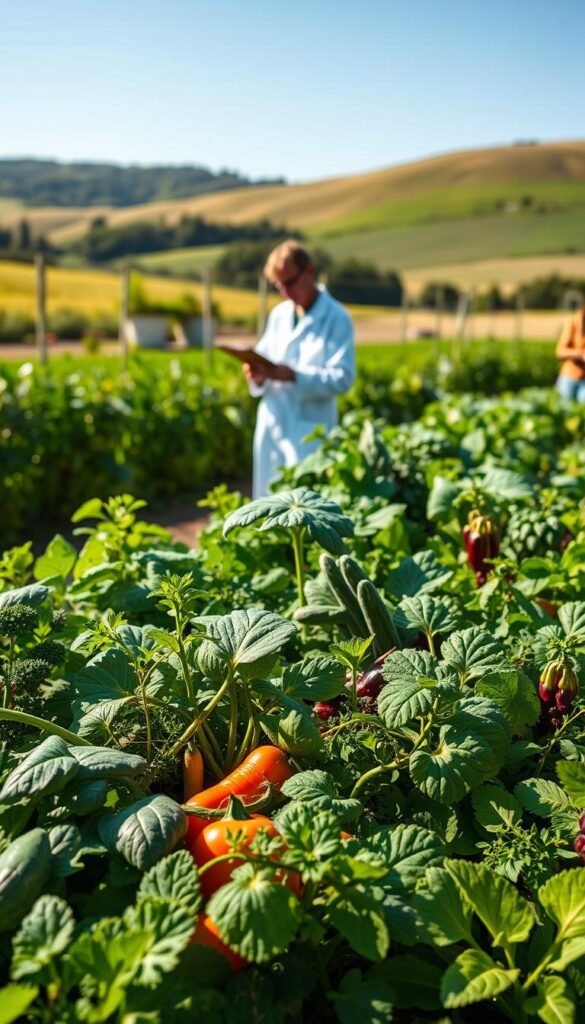
Plant partnerships aren’t just folklore—they’re proven science. Modern research shows how strategic pairings create healthier gardens through natural pest control and nutrient sharing. Let’s break down how these relationships work and why they matter.
What Companion Planting Is All About
This method uses plant chemistry and growth patterns to benefit crops. For example, marigolds release compounds that repel root-eating nematodes. Beans add nitrogen to soil, feeding corn planted nearby. These interactions form a living support system.
Exploring the Science Behind Plant Partnerships
Studies reveal seven key benefits when you mix certain species. Your greens deter pests through scent confusion—like onions masking carrot flies. Beneficial insects flock to flowers like dill and yarrow, eating aphids that harm veggies.
Soil quality improves when deep-rooted plants pull nutrients upward. Tall sunflowers shelter lettuce from harsh rays. Even spacing matters: alternating rows of cabbage with mint reduces caterpillar damage by 40% in trials.
You’ll find most combinations work harmoniously. Only a few plants, like black walnuts, release growth-stopping chemicals. Focus on proven pairs, and your garden becomes a self-regulating ecosystem.
Choosing the Right Plant Partners for Your Garden
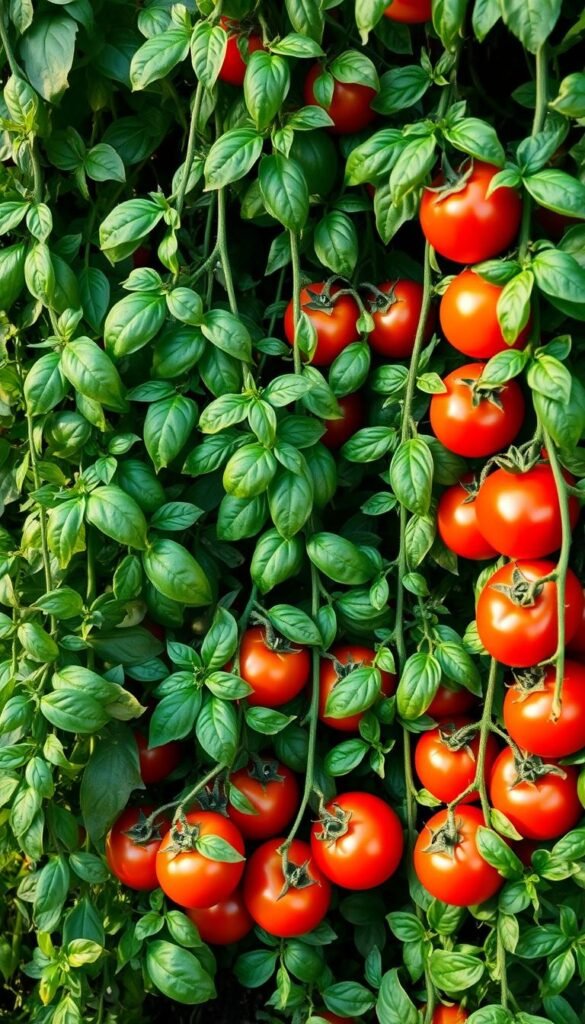
The secret to a flourishing garden lies in pairing plants that thrive together. These natural alliances create mutual benefits while reducing common growing challenges. Let’s explore how to match your greens for maximum success.
Benefits of Pairing Complementary Plants
Tomatoes grow stronger when nestled near basil—French researchers found basil’s aroma confuses pests targeting tomatoes. This fragrant herb doesn’t just deter insects—it also enhances tomato flavor in your recipes.
Corn stalks become natural supports for climbing beans in the Three Sisters method. As beans fix nitrogen in soil, squash leaves shade the ground below. This trio demonstrates how plants share resources while boosting yields.
How to Identify Good Neighbors in Nature
Flowers like marigolds and nasturtiums act as bodyguards for your veggies. Their bright blooms attract pollinators while repelling beetles and aphids. Herbs like dill bring ladybugs that devour harmful pests.
Observe wild ecosystems where shallow-rooted plants grow near deep-rooted species. Mimic these patterns in your garden beds. For example, pair lettuce (shallow roots) with carrots (deeper roots) to prevent nutrient competition.
Strategic pairings let you grow 25% more food in the same space. Start with proven combinations, then experiment with new plant friendships based on your garden’s unique conditions.
Developing Your Garden Planner with Companion Strategies
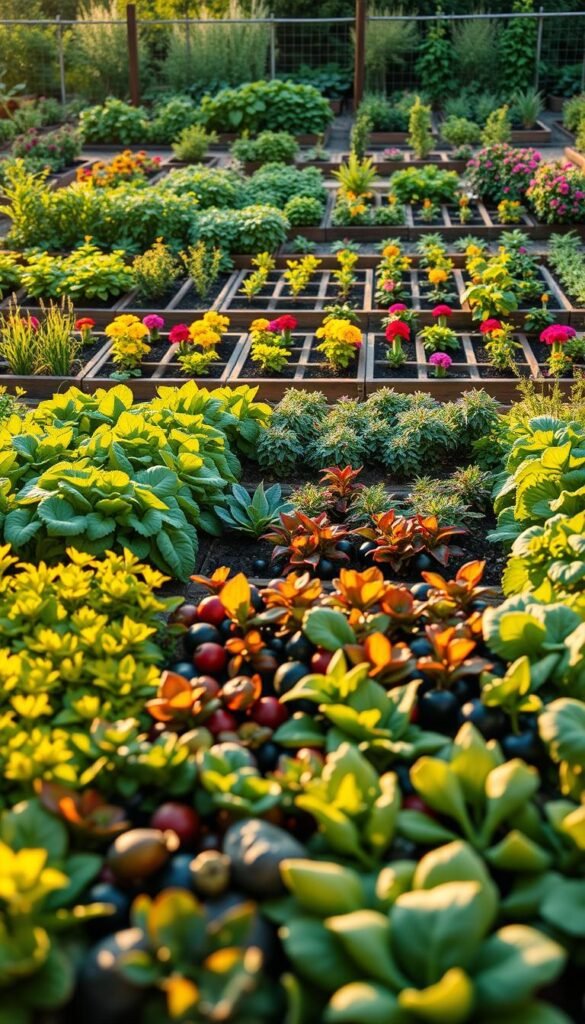
Transform your garden planning process with digital tools that simplify seasonal decisions. Modern resources blend centuries-old wisdom with cutting-edge research to help you maximize every square foot.
Utilizing Free Resources for Season Planning
Start with the free Garden Calendar—it’s like having a personal assistant for your growing season. Plug in your last spring frost date and first fall frost date. The tool calculates precise planting windows for 45+ common crops in your climate zone.
The Almanac Garden Planner takes it further with its new companion feature. Click the heart icon beside any vegetable to see which plants boost its growth. This works particularly well when planning square foot gardens, where space efficiency matters most.
Incorporating Research-Backed Suggestions
Leading agricultural universities reveal three rules for successful pairings: match root depths, stagger harvest times, and combine pest-fighting species. Their studies show proper companion planting increases yields by 18% compared to random arrangements.
Use your garden planner to sort plants by size and season. Pair quick-growing radishes (30 days) with slower peppers (90 days). When radishes finish, peppers get extra space—a smart way to double your harvests in one season.
Update your strategy each growing season using local extension service recommendations. These free guides specify which crops thrive in your area’s unique conditions, taking the guesswork out of gardening success.
Companion Planting Ideas for a Thriving Veggie Garden Layout
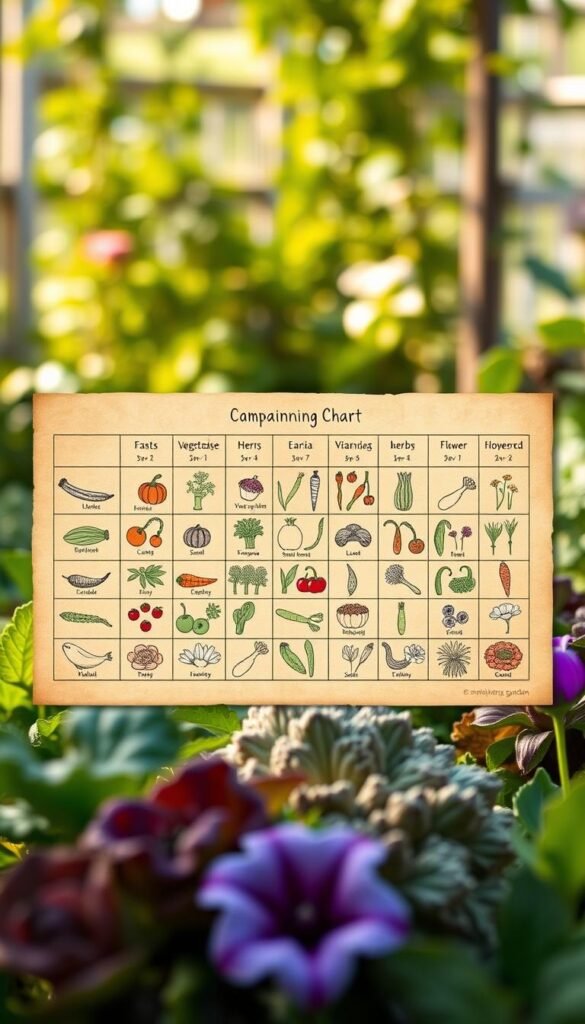
Transform your vegetable beds into thriving ecosystems with smart plant partnerships. Strategic combinations create natural pest barriers and nutrient-sharing systems that amplify growth. Let’s explore practical pairings that turn your garden into a collaborative powerhouse.
Beans become superstars when grown near nasturtiums. These vibrant flowers lure aphids away from bean vines, acting as sacrificial plants. For vertical gains, train pole beans up corn stalks—this duo boosts bean yields by 40% while corn provides sturdy support.
Onions work overtime when planted with carrots and lettuce. Their pungent aroma masks carrot flies and deters cutworms from tender greens. Studies show onion-carrot pairings increase root yields by 22%, making this combo a soil-space hero.
Basil transforms pepper patches into fragrant fortresses. This aromatic herb secretes compounds that repel spider mites while enhancing pepper flavor. For cabbage protection, plant rosemary or sage nearby—their strong scents confuse moths seeking brassica leaves.
Peas and leafy greens form the ultimate sharing circle. As peas fix nitrogen in soil, lettuce and spinach soak up the nutrient boost. This partnership works beautifully when rotating crops through seasonal beds.
Flower power completes the equation. Marigolds and calendula attract predator insects that devour aphids, creating self-regulating pest control. Interplant these bloomers throughout beds for continuous protection without chemicals.
Designing Your Vegetable Garden Layout for Maximum Yield
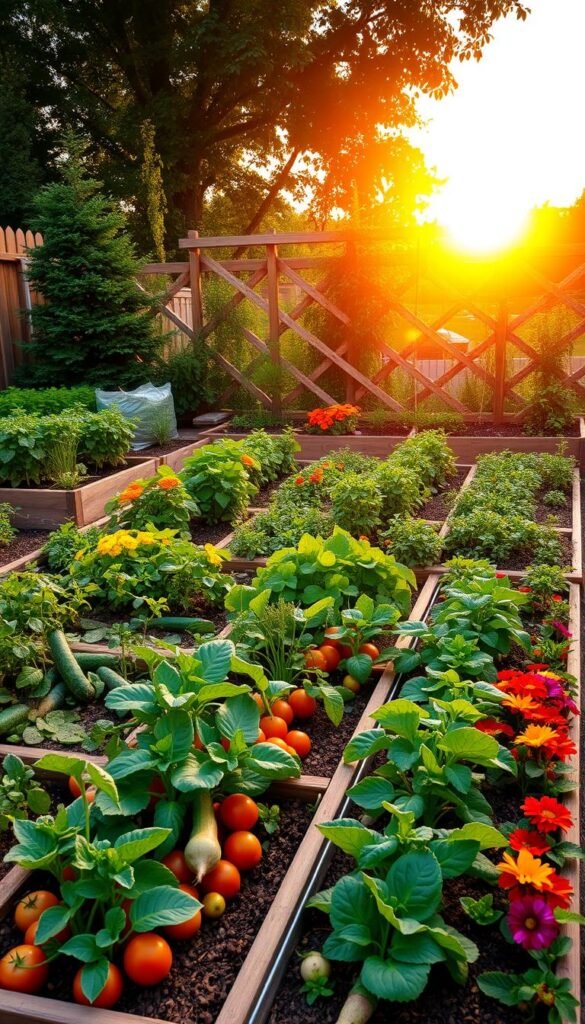
Smart garden design turns sunlight and soil into your greatest allies. Position plants based on their light needs and growth habits to create a high-yield space that works harder for you. This approach helps every square foot contribute to your harvest.
Managing Light and Space for Different Crops
Heat-loving tomatoes demand prime real estate with 6-8 hours of sun. Pair them with peppers and eggplants along your garden’s sunniest edge. These sun worshippers produce 40% more fruit when basking in full light.
Leafy greens thrive in partial shade during summer’s peak. Tuck spinach and lettuce beneath corn stalks – the tall plants filter harsh rays while creating cool microclimates. Studies show greens grown this way stay tender 50% longer.
Intercropping and Vertical Gardening Tips
Plant radishes between slow-growing squash hills. You’ll harvest the roots before squash vines spread. This space-saving trick lets you grow two crops where one would normally fit.
Train peas and pole beans up trellises to free up ground space. Hanging baskets work wonders for cherry tomatoes, keeping fruits clean and pest-free. Vertical structures can boost yields by 30% in small gardens.
Arrange plants by height: tallest in the north, shortest southward. This layout ensures all vegetables get adequate light without shading neighbors. Bush beans flourish in the dappled light beneath corn, proving opposites attract in the garden.
Practical Tips for a Healthy, Productive Garden
Your green space becomes more resilient when you work with its natural rhythms. Simple strategies can boost soil health while keeping pests in check—no harsh chemicals needed.
Enhancing Soil Fertility and Natural Pest Control
Start with radishes as undercover defenders. University of Nebraska research shows planting them near squash deters squash bugs. The peppery roots act like natural repellents while improving soil structure.
Mix plants strategically to confuse harmful insects. Intercropping basil with tomatoes reduces whiteflies by 43%. Marigolds work best when sown alongside tomatoes from the start—their roots release pest-blocking compounds over time.
Legumes are your soil’s best friends. Beans and peas convert air nitrogen into plant-ready nutrients. Pair them with heavy feeders like corn for a natural fertilizer boost. Deep-rooted plants like burdock mine minerals from subsoil, sharing them with shallow-rooted neighbors.
Flowers bring the cavalry. Calendula and zinnias attract hoverflies that devour aphids. For maximum impact, create diverse plant groupings that bloom throughout the season.
Try this three-step approach:
- Rotate nitrogen-fixers through beds annually
- Edge squash patches with radish rows
- Frame tomato beds with marigold borders
These methods create a self-regulating system. As plant partnerships strengthen, you’ll spend less time battling pests and more time harvesting.
Wrapping Up Your Garden Journey
Creating a vibrant garden combines smart strategies with nature’s wisdom. While companion planting offers exciting benefits, remember your plants’ core needs come first. Proper spacing, sunlight access, and nutrient-rich soil form the foundation every thriving garden requires.
Start simple by adding marigolds or zinnias near tomatoes. These colorful bloomers attract helpful insects while letting you observe partnerships in action. Calendula and basil make great starter plants too—they’re easy to grow and benefit nearby veggies.
Research keeps revealing new insights about plant relationships. What works today might evolve tomorrow. Stay curious! Try pairing nasturtiums with squash or borage with strawberries, then note what happens.
Your garden thrives when you balance experimentation with fundamentals. Water consistently, feed the soil, and give crops room to breathe. These practices work hand-in-hand with companion planting to create resilient, productive spaces.
Now’s the perfect time to begin. Tuck a few beneficial flowers between your veggies and watch nature’s teamwork unfold. Every small step brings you closer to a garden that grows smarter each season.

